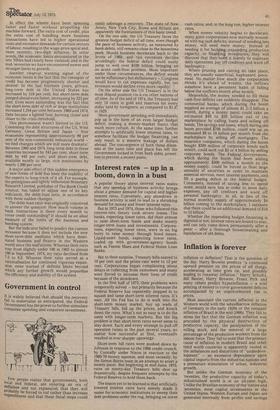Interest rates up in a boom, down in a bust
A popular theory about interest rates states that any speedup of business activity brings about a greater demand for capital and higher interest rates. Conversely, any slowdown in business activity is said to lead to a shrinking demand for money and lower interest rates.
But in 1973 and 1974, those who followed this interest-rate theory took severe losses. The banks, expecting lower rates, did their utmost to raise short-term funds and make mostly longer-term loans and investments. Corporations, expecting lower rates, were in no big hurry to raise money through bond issues. Liquid-asset funds, expecting lower rates, loaded up with government-agency bonds such as Fannie Maes and Federal Home Loan Banks.
But to their surprise, Treasury bills soared to 10 per cent and the prime rate went to 12 per cent. Corporations began complaining about delays in collecting from customers and many were forced to increase their lines of credit because of the slowdown.
In the first half of 1975, their problems were temporarily solved — but primarily because the Federal Reserve has repeatedly stepped in to squash and tame short-term interest rates. It's easy. All the Fed has to do is walk into the short-term money market, buy up wads of Treasury bills, bid up the prices, and knock down the rates. What's not so easy is to do the same with longer-term markets. But the big problem is that short-term rates never seem to stay down. Each and every attempt to pull off operation twists in the past several years, no matter how successful at first, eventually resulted in ever sharper upswings.
Short-term bill rates were pushed down by Johnson in response to the 1966 credit crunch, by Connally under Nixon in reaction to the 1969-70 money squeeze, and most recently, by the Simon-Burns team in an attempt to avert a money panic. But beginning in mid-June, 1975, rates on ninety-day Treasury bills shot up dramatically, despite frequent attempts by the Federal Reserve to hold them back.
The lesson yet to be learned is that artificially lowered interest rates have merely made it easier for economic institutions to sweep their debt problems under the rug, bringing on lower
cash ratios, and, in the long run, higher interest rates.
When money velocity begins to decelerate, many giant corporations now mortally wounded with big cash deficits, instead of needing less money, will need more money. Instead of needing it for building, expanding productive capacity, or financing inventories, they will discover that they need it merely to maintain daily operations, pay off creditors and ward off bankruptcy.
Where pruning and cutting do take place, they are usually superficial, haphazard, piecemeal. No matter how much the corporation thinks it's ahead of events, the inflows somehow have a persistent habit of falling below the outflows month after month.
Meanwhile, the money needed to fill these cash-flow deficits can suddenly disappear. The commercial banks, which during the boom supplied an average of almost $1 2/3 billion a month, during a money panic could take an estimated $40 to $50 billion out of the marketplace by calling loans and selling off bonds. The savings and loans, which during the boom provided $700 million, could sop up an estimated $8 to 10 billion per month from the marketplace by selling off mortgages. The insurance companies, which during the boom bought $300 million of corporate bonds each month, could suck out $3 or 4 billion by selling corporate bonds. The Federal Government, which during the boom had been adding approximately $500 million a month to the money supply, could be forced to float large amounts of securities in order to maintain essential services, meet interest payments, and fill a gaping deficit in the federal budget. Consumers, instead of saving less to spend more, would save less in order to meet daily expenses, pay off creditors and ward off personal bankruptcy. In all, in lieu of the normal monthly supply of approximately $4 billion coming to the marketplace, I estimate that there could be an additional demand of $10 to 15 billion!
Whether the impending budget financing is digested or not, interest rates are bound to soar, and can only come down permanently after a panic — after a thorough housecleaning and liquidation of old debts.


































 Previous page
Previous page